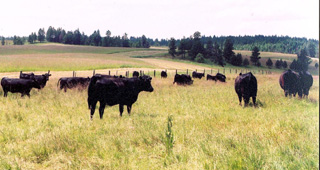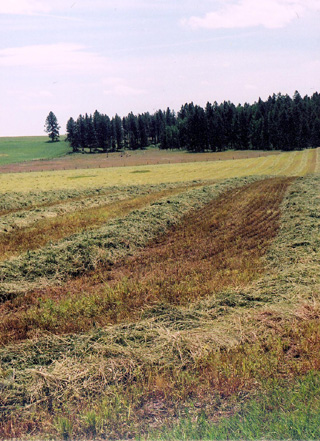| Ferdinand
Producer Finds a Helping Hand with Conservation Programs
Dirk Ewing is no stranger to conservation practices, having entered into long-term agreements on his Montana ranch. 
But when the remote Montana ranch was made part of a wilderness area, restrictions made ranching nearly impossible. Ewing and his wife Becky looked to Idaho. They moved their Black Angus operation to the small farming community of Ferdinand, where Main Street features only a bar/restaurant and a post office. But the small-town atmosphere hasn’t kept Ewing from updating his ranching practices. Every six months he goes to the USDA Natural Resources Conservation Service (NRCS) in Nezperce and Grangeville to see what they have to offer. “We couldn’t have done all this with our own money,” he says of the laundry list of projects. He has thinned timber and planted trees. He has converted crop land to hay. He has built stock troughs, drilled wells, fenced creek bottoms and cross-fenced. While completed projects can be seen across his Ferdinand ranch, nearly all the practices have also happened on over 500 acres to the north, near Winchester. “We’ve probably tapped into as many projects as anyone,” says the rancher who sells breeding stock in five states.  The
Winchester project took 320 acres of grain fields and converted them to
hay. Another 200 acres of timberland on the canyon bordering the hay ground
was thinned with the help of a NRCS forester. New fencing keeps cattle
out of fragile areas while spring water is piped to where it is needed.
Most of the $40,000 project—75 percent cost-share—came from NRCS’ Environmental
Quality Incentives Program (EQIP). And while it is supposed to be a five-year
project, Ewing says he has trouble moving at that pace and completed all
the work in three months. The
Winchester project took 320 acres of grain fields and converted them to
hay. Another 200 acres of timberland on the canyon bordering the hay ground
was thinned with the help of a NRCS forester. New fencing keeps cattle
out of fragile areas while spring water is piped to where it is needed.
Most of the $40,000 project—75 percent cost-share—came from NRCS’ Environmental
Quality Incentives Program (EQIP). And while it is supposed to be a five-year
project, Ewing says he has trouble moving at that pace and completed all
the work in three months.
Ewing estimates he has tapped into about $100,000 in conservation money. “If you don’t continually improve it, you fall behind,” Ewing says. Kevin Seitz, NRCS district conservationist in Nezperce, says installing conservation practices costs upfront money and conservation programs help give producers the added incentive to do the work. “The programs are allowing them to install practices they wouldn’t be able to do on their own,” he says. Utilizing conservation funds isn’t always easy, though. Because most projects are on a reimbursable cycle, the producer has to spend the money first. If he doesn’t have the operating capital, it can be difficult. Ewing says many of the projects, including better watering systems and cross-fencing, mean less time handling the cows and less labor cost, making his operation more cost-effective over the long run. A little work remains on the Winchester ground including planting some seedlings, adding missing species to the pine trees. “Because we are set up to do this, it really benefits us,” Ewing says. |
|